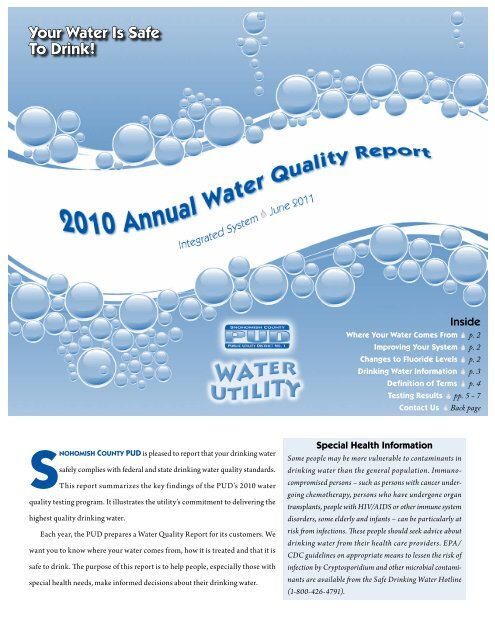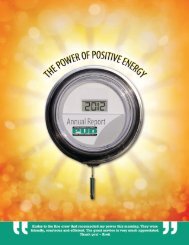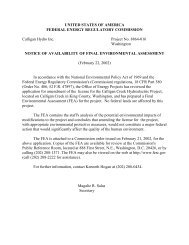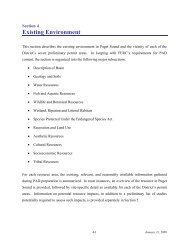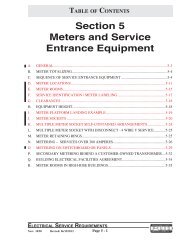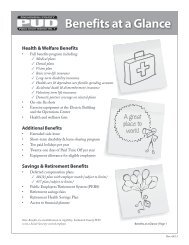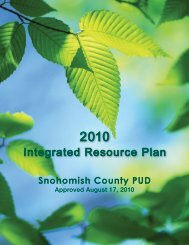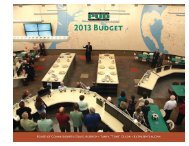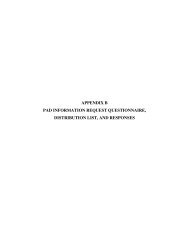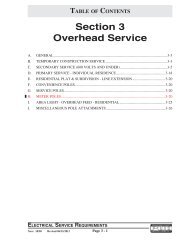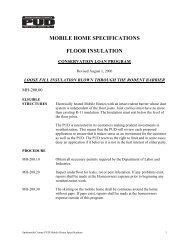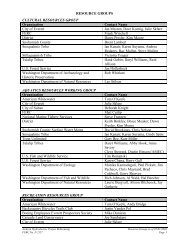Your Water Is Safe To Drink! - Snohomish County PUD
Your Water Is Safe To Drink! - Snohomish County PUD
Your Water Is Safe To Drink! - Snohomish County PUD
Create successful ePaper yourself
Turn your PDF publications into a flip-book with our unique Google optimized e-Paper software.
<strong>Your</strong> <strong>Water</strong> <strong>Is</strong> <strong>Safe</strong><br />
<strong>To</strong> <strong>Drink</strong>!<br />
Inside<br />
Where <strong>Your</strong> <strong>Water</strong> Comes From p. 2<br />
Improving <strong>Your</strong> System p. 2<br />
Changes to Fluoride Levels p. 2<br />
<strong>Drink</strong>ing <strong>Water</strong> Information p. 3<br />
Definition of Terms p. 4<br />
Testing Results pp. 5 - 7<br />
Contact Us<br />
Back page<br />
<strong>Snohomish</strong> <strong>County</strong> <strong>PUD</strong>is pleased to report that your drinking water<br />
safely complies with federal and state drinking water quality standards.<br />
This report summarizes the key findings of the <strong>PUD</strong>’s 2010 water<br />
quality testing program. It illustrates the utility’s commitment to delivering the<br />
highest quality drinking water.<br />
Each year, the <strong>PUD</strong> prepares a <strong>Water</strong> Quality Report for its customers. We<br />
want you to know where your water comes from, how it is treated and that it is<br />
safe to drink. The purpose of this report is to help people, especially those with<br />
special health needs, make informed decisions about their drinking water.<br />
Special Health Information<br />
Some people may be more vulnerable to contaminants in<br />
drinking water than the general population. Immunocompromised<br />
persons – such as persons with cancer undergoing<br />
chemotherapy, persons who have undergone organ<br />
transplants, people with HIV/AIDS or other immune system<br />
disorders, some elderly and infants – can be particularly at<br />
risk from infections. These people should seek advice about<br />
drinking water from their health care providers. EPA/<br />
CDC guidelines on appropriate means to lessen the risk of<br />
infection by Cryptosporidium and other microbial contaminants<br />
are available from the <strong>Safe</strong> <strong>Drink</strong>ing <strong>Water</strong> Hotline<br />
(1-800-426-4791).
<strong>Snohomish</strong> <strong>County</strong> <strong>PUD</strong> • 2010 Annual <strong>Water</strong> Quality Report<br />
Where <strong>Your</strong> <strong>Water</strong> Comes From<br />
The <strong>PUD</strong>’s water service territory: Greater Lake Stevens,<br />
Arlington & Granite Falls <strong>Water</strong> System. (The <strong>PUD</strong> does not<br />
provide water to the cities of Marysville and <strong>Snohomish</strong>.)<br />
The water distributed to your home is purchased from the City of Everett. The<br />
water comes from the Spada Lake Reservoir, which is located at the headwaters<br />
of the Sultan River about 30 miles east of Everett.<br />
Spada Reservoir is located in the Sultan Basin <strong>Water</strong>shed, which covers nearly<br />
84 square miles. A watershed is a geographic area where all precipitation drains<br />
into a single body of water. In the Sultan Basin <strong>Water</strong>shed, rainfall and snowmelt<br />
from the Cascade Mountains flow into Spada Reservoir. One of the wettest watersheds<br />
in the continental United States, the basin’s average rainfall is about 165<br />
inches.<br />
Created in 1965 by construction of the Culmback Dam, and increased in size<br />
in 1984, Spada Lake Reservoir holds approximately 50 billion gallons of water.<br />
<strong>Water</strong> from Spada Lake travels eight miles by tunnel and pipeline to the <strong>PUD</strong>’s<br />
Jackson Hydroelectric Project where turbines generate enough power to supply<br />
electricity to about 35,800 homes.<br />
The water is then routed by pipeline from the powerhouse to Everett’s Lake<br />
Chaplain, where it is held in preparation for treatment. Everett’s treatment plant<br />
uses coagulation and advanced filtration techniques to remove suspended particles<br />
that may contaminate the water. The pH (acidity) of the water is adjusted<br />
to reduce its corrosiveness, thereby reducing the likelihood of lead and copper<br />
being leached from household plumbing. Chlorine is added as a disinfectant to<br />
make sure the water is free of harmful microorganisms, and f luoride is added<br />
for enhanced dental protection. The levels of these two additives are monitored<br />
constantly to assure proper dosages are being used.<br />
Improving <strong>Your</strong> System<br />
The <strong>PUD</strong> completed several system improvements in 2010.<br />
All projects were completed under original cost estimates.<br />
There were seven water main replacements across the<br />
county, upgrading approximately 11,500 feet of failing infrastructure.<br />
Main replacements were completed in the Kayak<br />
Point area of Stanwood, Dutch Hill in <strong>Snohomish</strong> and various<br />
locations around Lake Stevens. The <strong>PUD</strong> added 6,000<br />
feet of new 12-inch ductile iron main in conjunction with<br />
the Granite Falls Alternate Route road construction. A new<br />
water tank was constructed at Hillcrest Reservoir, adding<br />
three million gallons of storage to the system.<br />
Changes to Fluoride Levels<br />
in <strong>Your</strong> <strong>Drink</strong>ing <strong>Water</strong><br />
On January 7, 2011, the U.S. Department of Health and<br />
Human Services announced a change to the recommended<br />
levels for fluoridation of drinking water. The new range of<br />
0.7 mg/L to 1.2 mg/L is lower than the previously recommended<br />
range of 0.8mg/L to 1.3 mg/L. Acting on advice<br />
from the Washington State Department of Health and the<br />
<strong>Snohomish</strong> Health District, the City of Everett adjusted its<br />
target dose from 1 mg/L to 0.8 mg/L. <strong>Snohomish</strong> <strong>County</strong><br />
<strong>PUD</strong> purchases treated, filtered, fluoridated water from the<br />
City of Everett and distributes it directly to our customers.<br />
The City of Everett began adding fluoride to the water supply<br />
in 1992, after a vote of the people, for dental health<br />
reasons.<br />
2 – <strong>Snohomish</strong> <strong>County</strong> <strong>PUD</strong> Integrated <strong>Water</strong> System
<strong>Snohomish</strong> <strong>County</strong> <strong>PUD</strong> • 2010 Annual <strong>Water</strong> Quality Report<br />
General Information About <strong>Drink</strong>ing <strong>Water</strong><br />
SUBSTANCES EXPECTED TO BE IN DRINKING WATER<br />
<strong>To</strong> ensure that tap water is safe to<br />
drink, the Washington State Department<br />
of Health and the U.S. Environmental<br />
Protection Agency (EPA) set<br />
regulations limiting the amount of<br />
certain contaminants in the water provided<br />
by public water systems. The U.S.<br />
Food & Drug Administration (FDA)<br />
and the Washington State Department<br />
of Agriculture regulations establish<br />
limits for contaminants in bottled water<br />
that must provide the same protection<br />
for public health. <strong>Drink</strong>ing water,<br />
including bottled water, may reasonably<br />
be expected to contain at least<br />
small amounts of some contaminants.<br />
The presence of contaminants does<br />
not necessarily indicate that the water<br />
poses a health risk. More information<br />
about contaminants and potential health effects can be obtained by calling the<br />
EPA’s <strong>Safe</strong> <strong>Drink</strong>ing <strong>Water</strong> Hotline at 1-800-426-4791.<br />
The sources of drinking water (both tap water and bottled water) include<br />
rivers, lakes, streams, ponds, reservoirs, springs and wells. As water travels over<br />
the surface of the land or through the ground, it dissolves naturally occurring<br />
minerals – in some cases, radioactive material – and substances resulting from<br />
the presence of animals or from human activity. The following substances may be<br />
present in source water (drinking water quality is determined by testing for these<br />
contaminants).<br />
Microbial contaminants<br />
such as viruses and bacteria<br />
Inorganic contaminants<br />
such as salts and metals<br />
Pesticides & herbicides<br />
Organic contaminants<br />
including synthetic and<br />
organic chemicals<br />
Radioactive<br />
contaminants<br />
May come from wildlife, agricultural livestock or septic<br />
systems.<br />
Can occur naturally or may result from urban stormwater<br />
runoff, industrial or domestic wastewater discharges,<br />
mining or farming.<br />
May come from a variety of sources such as farming, urban<br />
stormwater runoff, and homes or businesses.<br />
Are by-products of industrial processes and petroleum<br />
production and may also come from gas stations, urban<br />
stormwater runoff and septic systems.<br />
Can be naturally occurring or may be the result of oil and<br />
gas production and mining activities.<br />
<strong>Water</strong> Conservation Requirements<br />
The <strong>Water</strong> Use Efficiency Rule sets planning requirements, leakage standards and water conservation goal setting and<br />
reporting requirements. The <strong>PUD</strong>’s 2010 demand-side and supply-side conservation goal results:<br />
Demand-<br />
Side<br />
Supply-<br />
Side<br />
Goal 2010 Results How Goal was Met<br />
Participate in the Everett <strong>Water</strong> Utilities<br />
Committee regional conservation program<br />
to help reduce the 2012 regional demand<br />
for water by 3% [equivalent to 1.97 million<br />
gallons per day (MGD)].<br />
Maintain the <strong>PUD</strong>’s distribution system<br />
leakage below the state standard of 10%<br />
and strive to progressively achieve lower<br />
percentages of non-revenue water, where<br />
possible.<br />
Savings of 1.97 MGD<br />
(for further information,<br />
see City of Everett<br />
report on-line at<br />
www.everettwa.org)<br />
6.2% unaccounted-for<br />
water<br />
Public outreach and education, distribution<br />
of indoor/outdoor conservation kits,<br />
toilet and efficient appliance rebates, leak<br />
detection and commercial spray nozzle<br />
replacements.<br />
Continued emphasis on accurate water<br />
usage reporting with <strong>PUD</strong> crews and<br />
local fire departments and with distribution<br />
system leak detection.<br />
<strong>Snohomish</strong> <strong>County</strong> <strong>PUD</strong> Integrated <strong>Water</strong> System – 3
<strong>Snohomish</strong> <strong>County</strong> <strong>PUD</strong> • 2010 Annual <strong>Water</strong> Quality Report<br />
Definition of Terms Used in This Report<br />
How Do I Read This Report?<br />
The Maximum Allowable column provides you with the maximum level<br />
established by the EPA or the Department of Health. These are standards<br />
that all drinking water suppliers serving over 15 customers must meet.<br />
The Minimum/Maximum Range and Average Value show you the contaminant<br />
level detected in the water analysis test.<br />
The last column tells you whether or not the test complies with<br />
regulations. A “YES” indicates that the range detected is within EPA regulations.<br />
<strong>Snohomish</strong> <strong>County</strong> <strong>PUD</strong> also regularly performs tests for unregulated<br />
compounds for which state and federal agencies have not set standards at<br />
this time.<br />
AL (Action Level): The concentration of a contaminant,<br />
which, if exceeded, triggers treatment or other requirements<br />
that a water system must follow.<br />
MCL (Maximum Contaminant Level): The highest level<br />
of a contaminant that is allowed in drinking water. MCLs are<br />
set as close to the MCLGs as feas i ble, using the best available<br />
treatment technology.<br />
MCLG (Maximum Contaminant Level Goal): The level<br />
of a contaminant in drinking water below which there is<br />
no known or expected risk to health. MCLGs allow for a<br />
margin of safety.<br />
MRDL (Maximum Residual Disinfectant Level): The<br />
highest level of disinfectant allowed in drinking water. There<br />
is convincing evidence that the addition of a disinfectant<br />
(e.g., chlorine, chloramines, chlorine dioxide) is necessary<br />
for control of microbial contaminants.<br />
MRDLG (Maximum Residual Disinfectant Level<br />
Goal): The level of a drinking water disinfectant below<br />
which there is no known or expected risk to health.<br />
MRDLGs do not reflect the benefits of the use of disinfectants<br />
to control microbial contaminants.<br />
N/A: The EPA has not set MCLGs for these substances.<br />
N/D: Not detected.<br />
NTU (Nephelometric Turbidity Units): Measurement<br />
of the clarity, or turbidity, of water.<br />
ppm (parts per million): One part per million (corresponds<br />
to one dollar in $1,000,000).<br />
ppb (parts per billion): One part per billion (corresponds<br />
to one dollar in $1,000,000,000).<br />
pCi/L (picocuries per liter): a measure of radioactivity.<br />
SMCL (Secondary Maximum Contaminant Level):<br />
These standards are developed to protect the aesthetic qualities<br />
of drinking water and are not health-based.<br />
TT (Treatment Technique): A required process intended<br />
to reduce the level of a contaminant in drinking water.<br />
Turbidity: Has no health effects. However, turbidity<br />
can interfere with disinfection and provide a medium for<br />
microbial growth. Turbidity may indicate the presence of<br />
disease-causing organisms that include bacteria, viruses<br />
and parasites. These organisms can cause symptoms such as<br />
nausea, cramps, diarrhea and associated headaches.<br />
4 – <strong>Snohomish</strong> <strong>County</strong> <strong>PUD</strong> Integrated <strong>Water</strong> System
<strong>Snohomish</strong> <strong>County</strong> <strong>PUD</strong> • 2010 Annual <strong>Water</strong> Quality Report<br />
greater lake stevens, arlington and granite falls water system<br />
The <strong>PUD</strong>’s Integrated System is supplied water from the City of Everett’s transmission main through six master meters. The system provides water to over 20,000 connections<br />
(estimated customer base of approximately 47,000 people) and includes over 384 miles of pipe, 15 million gallons of storage, 4 pump stations, 3 gravity supply taps,<br />
1 emergency backup well field and 19 major pressure zones.<br />
EPA Regulations<br />
<strong>Your</strong> <strong>Water</strong> Testing Results<br />
Ideal Level/ Maximum Min./Max. Average or<br />
Substance Major Source Units Goal (MCLG) Allowable (MCL) Range Highest Value Comply?<br />
Nitrate Erosion of natural deposits, animal waste ppm 10 10 0.10 – 0.11 0.08 YES<br />
<strong>To</strong>tal Coliform Bacteria Naturally present in the environment % positive 0 Not more than 5% 0– 4% 4% YES<br />
positive per month<br />
<strong>To</strong>tal coliform bacteria testing is used to monitor microbial quality in the water distribution system. The <strong>PUD</strong> collects 50 coliform samples per month from dedicated sites within the Lake<br />
Stevens Integrated <strong>Water</strong> System. Not more than 5 percent of the monthly total can be positive for total coliforms. During the month of May 2010, two coliform samples tested as unsatisfactory.<br />
Additional samples were taken in response. All of the follow-up samples tested satisfactory with no coliform detected.<br />
Fluoride Dental health additive ppm 2 4 0.7 – 1.1 0.9 YES<br />
Fluoride is added to your water in carefully controlled levels for dental health.<br />
Haloacetic Acids By-product of drinking water chlorination ppb N/A 60 21.4 – 38.3 30.7 YES<br />
<strong>To</strong>tal Trihalomethanes By-product of drinking water chlorination ppb N/A 80 26.7 – 52.3 39.4 YES<br />
Free Chlorine Residual Measure of disinfectant added to water ppm 4 (MRDLG) 4 (MRDL) 0.1 – 1.4 0.7 YES<br />
Haloacetic acids and Trihalomethanes form as by-products of the chlorination process that is used to kill or inactivate disease-causing microbes.<br />
Turbidity Soil erosion NTU N/A TT 100% 0.10 YES<br />
Turbidity is a measure of the amount of particulates in water measured in Nephelometric Turbidity Units (NTU). Particulates in water can include bacteria, viruses and protozoans that<br />
can cause disease. Turbidity measurements are used to determine the effectiveness of the treatment processes used to remove these particulates. Values reported are the lowest monthly<br />
percentage of samples that meet the turbidity limit (0.3 NTU for EPA and 0.1 NTU for the state) and the highest filtered water turbidity measurement obtained at the City of Everett <strong>Water</strong><br />
Filtration Plant in 2010.<br />
EPA Regulations<br />
<strong>Your</strong> <strong>Water</strong> Testing Results<br />
Ideal Level/ Action 90th Homes Exceeding<br />
Substance Major Source Units Goal (MCLG) Level (AL) % Level the AL Comply?<br />
Copper Plumbing, erosion of natural deposits ppm 1.3 1.3 0.19 None YES<br />
Lead Plumbing, erosion of natural deposits ppb 0 15 3 2 of 108 YES<br />
(1.9%)<br />
USEPA and state regulations require Everett and the systems it supplies to monitor for the presence of lead and copper at household taps in their service area every three years. The next<br />
round of required sampling will be conducted in late summer of 2012. The 90th % Level is the highest result obtained in 90 percent of the samples collected when the results are ranked in<br />
order from lowest to highest. The results for water tested before it enters household plumbing were even lower. This indicates that there is virtually no lead or copper in the water you are<br />
provided, but your household plumbing may contribute to the presence of lead and copper at your tap.<br />
UNREGULATED SUBSTANCES<br />
Ideal <strong>Your</strong> <strong>Water</strong> Testing Results<br />
Level/Goal Min./Max. Average<br />
Substance (MCLG) Range Value<br />
Bromodichloromethane 1 (ppb) 0 1.3 – 2.6 1.8<br />
Chloroform (trichloromethane) 1 (ppb) 70 25.4 – 56.4 38.0<br />
Dichloroacetic Acid 1 (ppb) 0 5.4 – 15.0 11.3<br />
Trichloroacetic Acid 1 (ppb) 300 12.0 – 28.3 16.9<br />
Monochloroacetic Acid 1 (ppb) 70 2.2 – 3.6 2.81<br />
1<br />
These substances are by-products of the chlorine disinfection process and were monitored<br />
quarterly during 2010 to determine compliance with the Stage 1 Disinfectants/Disinfection<br />
By-products Rule regulation.<br />
voluntarily monitored substances<br />
The information below is voluntary and describes additional characteristics of<br />
the drinking water purchased by the <strong>PUD</strong> from the City of Everett.<br />
Min./Max.<br />
Average<br />
Value<br />
Value<br />
Alkalinity (ppm) 11.7 – 20.3 15.7<br />
Aluminum (ppb) 0.01 – 0.04 .02<br />
Calcium Hardness (ppm) 7.8 – 12.6 9.4<br />
pH (standard unit) 7.4 – 8.9 8.1<br />
Sodium (ppm) 5.6 – 7.4 6.5<br />
<strong>To</strong>tal Hardness (ppm) 10.1 – 14.1 11.8<br />
<strong>Snohomish</strong> <strong>County</strong> <strong>PUD</strong> Integrated <strong>Water</strong> System – 5
6 – <strong>Snohomish</strong> <strong>County</strong> <strong>PUD</strong> Integrated <strong>Water</strong> System<br />
<strong>Snohomish</strong> <strong>County</strong> <strong>PUD</strong> • 2010 Annual <strong>Water</strong> Quality Report<br />
The Creswell, Dubuque, Lake Roesiger and Storm Lake Systems are also supplied water from the City of Everett; however, the<br />
systems are not hydraulically linked, which makes them separate or isolated systems. Therefore, in addition to the testing<br />
results found on page 5, the <strong>PUD</strong> collects supplementary compliance samples as shown in the following tables.<br />
water conservation tip<br />
LAWNS<br />
<strong>To</strong> reduce evaporation, water the lawn in the<br />
morning or evening. Avoid watering during the<br />
heat of the day or when it is windy.<br />
dubuque water system<br />
The Dubuque system supplies water to just over 1,000 connections in the Dubuque/Dutch Hill area. The water serving this area is purchased directly from<br />
the City of Everett; one tap is on Everett’s No. 3 pipeline, and two taps are on Everett’s No. 5 pipeline. The Dubuque system will ultimately be incorporated<br />
into the <strong>PUD</strong>’s integrated system.<br />
EPA Regulations<br />
<strong>Your</strong> <strong>Water</strong> Testing Results<br />
Ideal Level/ Maximum Min./Max. Average<br />
Substance Major Source Units Goal (MCLG) Allowable (MCL) Range Value Comply?<br />
<strong>To</strong>tal Coliform Bacteria Naturally present in the environment Samples 0 1 positive 0% 0% YES<br />
positive<br />
per month<br />
<strong>To</strong>tal coliform bacteria testing is used to monitor microbial quality in the water distribution system. The <strong>PUD</strong> collects three coliform samples per month. No unsatisfactory results were<br />
detected in 2010.<br />
Haloacetic Acids By-product of drinking water chlorination ppb N/A 60 3.8 – 40.7 28.1 YES<br />
<strong>To</strong>tal Trihalomethanes By-product of drinking water chlorination ppb N/A 80 33.0 – 47.2 37.9 YES<br />
Free Chlorine Residual Measure of disinfectant added to water ppm 4 (MRDLG) 4 (MRDL) 0.5 – 0.9 0.7 YES<br />
Haloacetic Acids and Trihalomethanes form as by-products of the chlorination process that is used to kill or inactivate disease-causing microbes.<br />
UNREGULATED SUBSTANCES<br />
creswell water system<br />
The Creswell system supplies water to 15 connections along Dubuque Road and Creswell Road. <strong>Water</strong> is purchased directly from the City of Everett with<br />
taps on Everett’s No. 2 and No. 3 pipelines.<br />
EPA Regulations<br />
<strong>Your</strong> <strong>Water</strong> Testing Results<br />
Ideal Level/ Maximum Min./Max. Average<br />
Substance Major Source Units Goal (MCLG) Allowable (MCL) Range Value Comply?<br />
<strong>To</strong>tal Coliform Bacteria Naturally present in the environment % positive 0 1 positive 0% 0% YES<br />
per month<br />
<strong>To</strong>tal coliform bacteria testing is used to monitor microbial quality in the water distribution system. The <strong>PUD</strong> collects one coliform sample per month. No unsatisfactory results were detected<br />
in 2010.<br />
Haloacetic Acids By-product of drinking water chlorination (ppb) N/A 60 21.7 – 38.6 32.1 YES<br />
<strong>To</strong>tal Trihalomethanes By-product of drinking water chlorination (ppb) N/A 80 33.0 – 40.8 39.1 YES<br />
Free Chlorine Residual Measure of disinfectant added to water (ppm) 4 (MRDLG) 4 (MRDL) 0.3 – 0.8 0.5 YES<br />
Haloacetic Acids and Trihalomethanes form as by-products of the chlorination process that is used to kill or inactivate disease-causing microbes.<br />
UNREGULATED SUBSTANCES<br />
Ideal <strong>Your</strong> <strong>Water</strong> Testing Results<br />
Level/Goal Min./Max. Average<br />
Substance (MCLG) Range Value<br />
Bromodichloromethane 1 (ppb) 0 1.6 – 2.0 1.7<br />
Chloroform (trichloromethane) 1 (ppb) 70 31.4 – 39.1 35.6<br />
Dichloroacetic Acid 1 (ppb) 0 11.0 – 17.2 14.7<br />
Trichloroacetic Acid 1 (ppb) 300 10.7 – 21.1 15.9<br />
Monochloroacetic Acid 1 (ppb) 70 3.0 – 3.1 3.1<br />
1<br />
These substances are by-products of the chlorine disinfection process and were monitored<br />
quarterly during 2010 to determine compliance with the Stage 1 Disinfectants/Disinfection<br />
By-products Rule regulation.<br />
Ideal <strong>Your</strong> <strong>Water</strong> Testing Results<br />
Level/Goal Min./Max. Average<br />
Substance (MCLG) Range Value<br />
Bromodichloromethane 1 (ppb) 0 1.5 – 2.4 1.8<br />
Chloroform (trichloromethane) 1 (ppb) 70 31.4 – 44.8 36.5<br />
Dichloroacetic Acid 1 (ppb) 0 1.5 – 16.4 12.0<br />
Trichloroacetic Acid 1 (ppb) 300 2.3 – 23.2 14.4<br />
Monochloroacetic Acid 1 (ppb) 70 2.9 – 3.4 3.1<br />
1<br />
These substances are by-products of the chlorine disinfection process and were monitored<br />
quarterly during 2010 to determine compliance with the Stage 1 Disinfectants/Disinfection<br />
By-products Rule regulation.<br />
water conservation tip<br />
RECYCLE<br />
Never pour water down the drain when there<br />
may be another use for it. Use it to water your<br />
indoor plants or garden.
<strong>Snohomish</strong> <strong>County</strong> <strong>PUD</strong> • 2010 Annual <strong>Water</strong> Quality Report<br />
lake roesiger water system<br />
Serving approximately 460 connections, the Lake Roesiger system supplies water to the Lake Roesiger community and surrounding area. <strong>Water</strong> is purchased<br />
directly from the City of Everett by one tap on Everett’s No. 3 pipeline at the south end of the lake. The water is then pumped to the distribution system and<br />
two concrete reservoirs at the north end of the lake.<br />
EPA Regulations<br />
<strong>Your</strong> <strong>Water</strong> Testing Results<br />
Ideal Level/ Maximum Min./Max. Average<br />
Substance Major Source Units Goal (MCLG) Allowable (MCL) Range Value Comply?<br />
<strong>To</strong>tal Coliform Bacteria Naturally present in the environment Samples 0 1 positive 0% 0% YES<br />
positive<br />
per month<br />
<strong>To</strong>tal coliform bacteria testing is used to monitor microbial quality in the water distribution system. The <strong>PUD</strong> collects two coliform samples per month. No unsatisfactory results were<br />
detected in 2010 .<br />
Haloacetic Acids By-product of drinking water chlorination ppb N/A 60 17.1 – 35.3 28.5 YES<br />
<strong>To</strong>tal Trihalomethanes By-product of drinking water chlorination ppb N/A 80 21.9 – 45.1 38.1 YES<br />
Free Chlorine Residual Measure of disinfectant added to water ppm 4 (MRDLG) 4 (MRDL) 0.1 – 0.9 0.5 YES<br />
Haloacetic Acids and Trihalomethanes form as by-products of the chlorination process that is used to kill or inactivate disease-causing microbes.<br />
UNREGULATED SUBSTANCES<br />
Ideal <strong>Your</strong> <strong>Water</strong> Testing Results<br />
Level/Goal Min./Max. Average<br />
Substance (MCLG) Range Value<br />
Bromodichloromethane 1 (ppb) 0 1.1 – 1.9 1.6<br />
Chloroform (trichloromethane) 1 (ppb) 70 20.8 – 43.2 31.1<br />
Dichloroacetic Acid 1 (ppb) 0 2.7 – 15.5 11.1<br />
Trichloroacetic Acid 1 (ppb) 300 13.6 – 19.5 16.1<br />
Monochloroacetic Acid 1 (ppb) 70 2.4 – 3.1 2.8<br />
1<br />
These substances are by-products of the chlorine disinfection process and were monitored<br />
quarterly during 2010 to determine compliance with the Stage 1 Disinfectants/Disinfection<br />
By-products Rule regulation.<br />
water conservation tip<br />
GENERAL<br />
Don’t use a hose to clean driveways, walkways or<br />
gutters. Turn off running water in the sink when<br />
washing your face, brushing your teeth or shaving.<br />
storm lake ridge water system<br />
The Storm Lake Ridge system supplies water to about 156 connections in the Storm Lake Ridge community and surrounding area approximately three miles<br />
east of Machias and five miles north of Monroe. <strong>Water</strong> is purchased directly from the City of Everett’s No. 5 pipeline and pumped to the distribution system<br />
and a concrete reservoir.<br />
EPA Regulations<br />
<strong>Your</strong> <strong>Water</strong> Testing Results<br />
Ideal Level/ Maximum Min./Max. Average<br />
Substance Major Source Units Goal (MCLG) Allowable (MCL) Range Value Comply?<br />
<strong>To</strong>tal Coliform Bacteria Naturally present in the environment Samples 0 1 positive 0% 0% YES<br />
positive<br />
per month<br />
<strong>To</strong>tal coliform bacteria testing is used to monitor microbial quality in the water distribution system. The <strong>PUD</strong> collects one coliform sample per month. No unsatisfactory results were detected<br />
in 2010.<br />
Haloacetic Acids By-product of drinking water chlorination ppb N/A 60 24.9 – 39.1 33.5 YES<br />
<strong>To</strong>tal Trihalomethanes By-product of drinking water chlorination ppb N/A 80 41.8 – 45.8 43.4 YES<br />
Free Chlorine Residual Measure of disinfectant added to water ppm 4 (MRDLG) 4 (MRDL) 0.3 – 0.9 0.6 YES<br />
Haloacetic Acids and Trihalomethanes form as by-products of the chlorination process that is used to kill or inactivate disease-causing microbes.<br />
UNREGULATED SUBSTANCES<br />
Ideal <strong>Your</strong> <strong>Water</strong> Testing Results<br />
Level/Goal Min./Max. Average<br />
Substance (MCLG) Range Value<br />
Bromodichloromethane 1 (ppb) 0 1.7 – 2.0 1.8<br />
Chloroform (trichloromethane) 1 (ppb) 70 34.9 – 41.3 39.3<br />
Dichloroacetic Acid 1 (ppb) 0 11.7 – 17.0 14.3<br />
Trichloroacetic Acid 1 (ppb) 300 11.8 – 23.1 16.9<br />
Monochloroacetic Acid 1 (ppb) 70 2.4 – 3.1 2.8<br />
1<br />
These substances are by-products of the chlorine disinfection process and were monitored<br />
quarterly during 2010 to determine compliance with the Stage 1 Disinfectants/Disinfection<br />
By-products Rule regulation.<br />
water conservation tip<br />
TOILET LEAKS<br />
Check toilets for leaks. Use food coloring or a leakdetection<br />
tablet in the toilet tank. If color appears in<br />
the bowl without flushing, there is a leak that requires<br />
immediate attention.<br />
<strong>Snohomish</strong> <strong>County</strong> <strong>PUD</strong> Integrated <strong>Water</strong> System – 7
<strong>Water</strong> Resources<br />
PO Box 1107<br />
Everett, WA 98206-1107<br />
presorted<br />
standard<br />
US POSTAGE paid<br />
EVERETT WA<br />
Permit No 193<br />
Customer Views Welcome<br />
There are several ways you can get involved in water quality<br />
issues. You can communicate with elected officials,<br />
participate in public hearings and attend <strong>Snohomish</strong><br />
<strong>County</strong> <strong>PUD</strong> Commission meetings. Check the local<br />
newspaper for information on public meetings regarding<br />
water quality, water policies and other issues, or call us at<br />
425-397-3000.<br />
The <strong>Snohomish</strong> <strong>County</strong> <strong>PUD</strong> Board of Commissioners<br />
meets at 1:30 pm on the first and third Tuesday of each<br />
month at <strong>Snohomish</strong> <strong>County</strong> <strong>PUD</strong>, 2320 California Street<br />
in Everett. Board sessions are open to the public. Please call<br />
425-783-8611 in advance to confirm meeting dates and<br />
times, or check the meeting agenda on our website.<br />
You can also find information for water customers at our<br />
website: www.snopud.com.<br />
<strong>Safe</strong> <strong>Drink</strong>ing <strong>Water</strong> &<br />
<strong>Water</strong> System Security<br />
The <strong>PUD</strong> is committed to a strong security program to protect<br />
water quality. The <strong>PUD</strong>’s facilities are secured; however,<br />
we could use your assistance. If you see suspicious activity<br />
in or around <strong>PUD</strong> pump stations, reservoirs or hydrants,<br />
please contact us at 425-397-3000 (after regular working<br />
hours, holidays or on weekends, please contact us at 425-<br />
783-8000).<br />
Este informe contiene información muy importante sobre<br />
su agua potable. Tradúzcalo o hable con alguien que<br />
lo entienda bien. <strong>Snohomish</strong> <strong>PUD</strong> participates in the AT&T<br />
language line ser vice. If you need help with the English language<br />
or need an interpreter, please contact a <strong>PUD</strong> customer ser vice<br />
representative at 425-783-1000 (Monday through Friday, 8 a m to<br />
5:30 pm) and an interpreter will be called (Se illamará a un intérprete).<br />
Contact Us<br />
For More Information<br />
• <strong>PUD</strong> Website: www.snopud.com (click on <strong>Water</strong>)<br />
<strong>Water</strong> Resources: 425-397-3000<br />
Monday through Friday, 7:30 am - 4:00 pm<br />
<strong>To</strong>ll-free in Western Washington and outside the<br />
Everett local calling area at 1-877-783-1000, extension 3000<br />
• <strong>Safe</strong> <strong>Drink</strong>ing <strong>Water</strong> Act (SDWA) Hotline:<br />
1-800-426-4791 • E-mail: hotline-sdwa@epamail.epa.gov<br />
• Washington State Department of Health Division of <strong>Drink</strong>ing <strong>Water</strong>:<br />
253-395-6750 • Website: www.doh.wa.gov/ehp/dw<br />
printed on recycled paper


